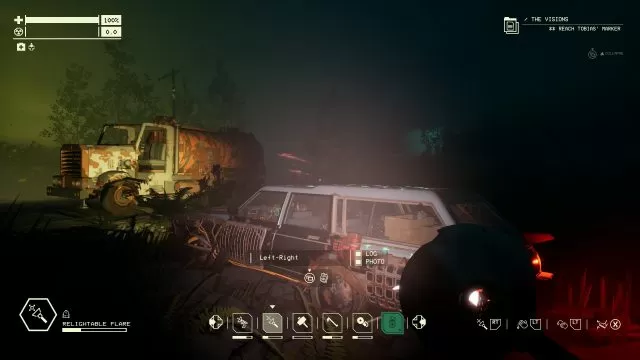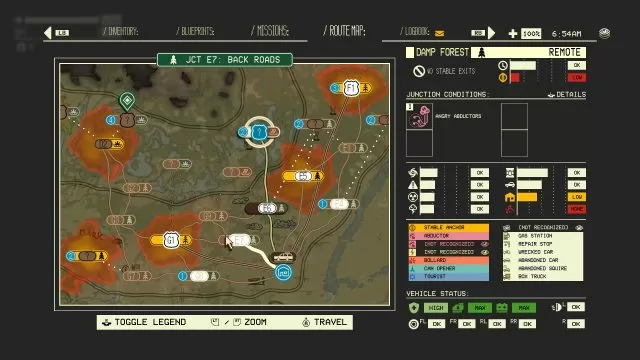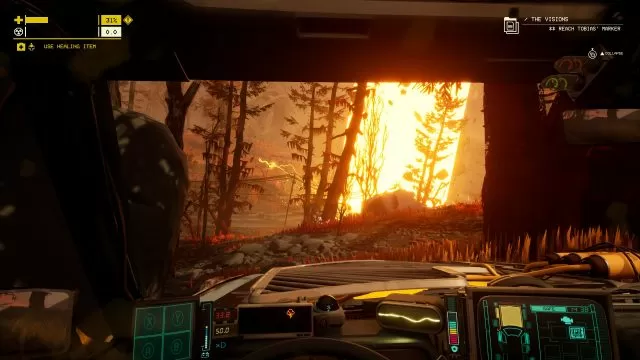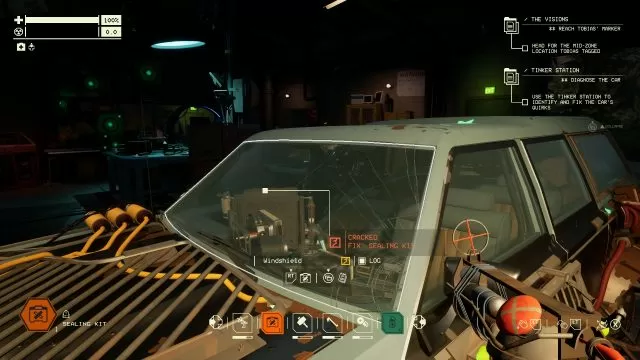Pacific Drive Review – Style over Substance
The Olympic Peninsula in the Pacific Northwest was one of the last uncharted places in the continental United States, having been mapped only at the tail-end of the XIX century. Almost four thousand square miles of pristine wilderness is sparsely inhabited even now. It contains a huge and beautiful national park, a popular hiking destination for Seattle-Tacoma hipsters from across the Puget Sound.
For some people, its dark pine forests project a different vibe. Seattle-based Ironwood Studios envisioned it as an American version of the Chernobyl exclusion zone. Pacific Drive imagines that at some point in mid XX century, a clandestine government/corporate entity chose the Olympic Peninsula as a site for advanced physics R&D. They dabbled in avant-garde science and tore the fabric of reality, turning the peninsula into a deathtrap of anomalies. A humongous wall was erected to isolate the zone and prevent chaos from spilling over. The Olympic Peninsula was thus sealed from the outside world.
Interstate love song

Fast forward a couple of decades, and the governmental “fix” started to crumble. Anomalies seep across the wall, and in a spectacular case of being in the wrong place at the wrong time, you and your car get sucked in one. Materialized on the other side, with your vehicle disintegrated, you ran like hell. In a classic deus-ex-machina fashion, you promptly stumbled upon a new set of wheels equipped with a radio, with helpful voices guiding you to safety. Ah, those life-saving coincidences…
Would you kindly proceed to the garage, driver? Situated in the stable part of the zone, the garage will serve as your home base. You’ll return there after each excursion into the wild, where you’ll gradually unbutton the layers of truth and grind for the resources needed for survival and progress. Pacific Drive, at its core, is a survival game, albeit a weird one. Apart from yourself, you need to take care of your station wagon, which is not an ordinary car. In Zone terminology, it’s a “remnant” – a special kind of anomaly that takes the form of random objects. It’s not sentient like the car from Knight Rider, nor is it alive in a classic sense. Hovewer, it has a presence of some sort that will gradually drive you insane. According to guys who were stuck in the zone for decades, you don’t have much time to find a way out before your mind is gone.
Take me home, country roads

Two former scientists and one grumpy old lady who was the chief architect of scientific effort in the Zone will guide and confuse you in equal measure. Initially, they’ll provide you with pointers on how to stay alive, maintain your car, and semi-safely explore the Zone. Occasionally, you’ll stumble upon scattered pieces of lore in the form of text/audio logs, which will gradually expand your knowledge about your deadly predicament. The Olympic Peninsula is an ever-shifting place. Each node on the map gets a randomized layout and conditions each day, with strong anomaly storms passing over the zone in an unpredictable pattern.
Such a grand setup, yeah? Too bad that its realization is quite boring. Pacific Drive is, unfortunately, one trick pony. Your interaction with the world outside your garage is limited to short excursions. Ninety percent of the time, you’ll cruise the sub-zones, avoiding the anomalies and stopping near empty cottages, abandoned gas stations, and vacant scientific installations. There, you will rummage through their trash. Utilizing various tools, you will scrape wrecked vehicles for metal, rubber, and plastic, hammer glass reactor housings for plasma. You’ll pilfer crates and trashcans for fabric, destroy ancient TV sets and radios for copper and electronics, and so on. It gets very, very stale after a couple of hours, and you’ll need more than twenty to reach the end.
Quasimodo behind the wheel

Avoiding the anomalies that would incur expensive damage to the car is, practically, the only interesting activity during those expeditions. Driving around pools of acidic miasma, localized electric fields or dozen other energy phenomena is exciting at first, until you realize it’s all there is. The view from the car is perma-obstructed by your low seating position and very large hood. Driving is okay-ish on the road during the day, but it becomes a nightmare of inconvenience when you stray off the asphalt, especially during the night. Driving never feels relaxed, it’s always weird and sometimes even unpleasant, especially when your car develops s quirk or five. Those manifest in myriad ways, from auto-switching wipers when exiting a car to auto-dimming lights when turning the wheel. Fortunately, you can diagnose and remove them in the garage.
I suppose prepping your car to better withstand the conditions on the road could be interesting to gearhead players out there. Or not, considering that the process doesn’t involve any realistic tuning or fixing. You’ll research and manufacture weird tech gizmos and gadgets, make insulated doors and panels, lead-platted bumpers, and whatnot. You’ll need more advanced stuff for deeper parts of the zone. During longer excursions, fuel, and battery capacity can become an issue. Carrying around jerrycans and jumper cables will be mandatory before you get the chance to research and build bigger tanks, more efficient batteries, and better engines.
Running on empty

Pacific Drive is a visually extremely stylish game. The dance of the colors and the shadows in the dusk is breathtaking, and the effect of the anomalies and the energy storms will sometimes leave your jaw hanging. I’ve recently upgraded to an OLED monitor on PC, so perhaps I’m a bit overhyped. The game, sadly, doesn’t support HDR, at least on PC. All things considered, it would be an ideal match for the display technology that is pretty much given on modern consoles.
My awe, however, doesn’t reach past visuals. Watching the pre-release teasers, I was under the impression that Pacific Drive would be a sort of an interactive road movie. Kind of a wild trek through impossible odds, like a vehicular embodiment of the Heart of Darkness novel. Instead, we got a rogue-lite car action with the interaction limited to avoiding colored blobs in the environment and recycling trash for progress. The narrative and the lore are solid, but not exceptional, and the same goes for acting. It all feels like a long-winded episode of X-Files crossed with American Pickers. Not my cup of tea, but your mileage may wary (bad pun intended).
Highs
- Interesting setup and competent narrative.
- Gorgeous visuals.
Lows
- Surviving and progressing is a matter of inconvenience and grind.
- Driving is no fun at all due to limited visibility behind the wheel.
- Another game with five-minute lasting flashlights.

